

Spoiler warning… Actually, this isn’t going to spoil stories any more recent than Hellboy: Being Human from 2011, except for B.P.R.D. Hell on Earth: The Devil’s Wings, and even then, it’s not a massive spoiler.
Before I can begin to talk about Roger, there’s something you must first understand about homunculi: They are like sponges. They absorb the traits of those around them and cobble together their personality together from these pieces. Roger’s personality went through several shifts during his life, and these shifts reflect the impressions made on him by others.

Now, let’s talk history.
Some time during the first millennium, in the city of Menouthis in Egypt, Ini-Herit wrote Flamma Reconditus, “The Secret Fire.” This book was a partial transcription of the Great Tabula Smaragdina, “The Emerald Table,” engraved by the Greek god Hermes on a stone that fell from the head of a fallen angel when he was cast from Heaven. However, The Secret Fire was not just a transcription; it was also a decoding. In The Secret Fire, Ini-Herit laid bare the secrets of the universe, and it contained an addendum of his notes on his experiments, including his work on the generation of homunculi.

In 1533, Czege Castle, Romania, Mischrasse created his second human-sized homunculus. It was a masterpiece, the finest homunculus ever made. Mischrasse cared for this homunculus and taught him, but the homunculus had been brought to life by a bolt of lightning, and over time its power faded. When it had no strength left to move or speak, Mischrasse left it in his laboratory. Perhaps he meant to return when he had solved the riddle of keeping it alive.
While both homunculi were eventually abandoned by their creator, both had very different relationships with Mischrasse. I believe this treatment during their formative years played a substantial role in their individual development.

The second homunculus wasn’t able to wake itself like its brother. It dreamed in the alchemist’s secret laboratory, forgotten by the world.
In March 1997, three B.P.R.D. agents, Bud Waller, Sidney Leech, and Elizabeth Sherman, were investigating the ruins of Czege Castle when they found the hidden entrance to Mischrasse’s laboratory.
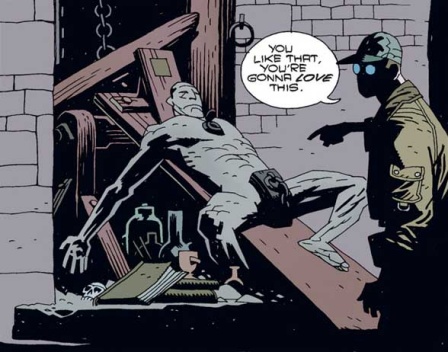
Agent Waller recognised the homunculus at once; he’d seen one before during the clean-up in Prague after Hellboy’s bout with the Verger of Saint Peter’s Church.1 He’d never heard of a homunculus so large though.
Continued below
Leech tried to yank Liz away, but he burned his hands on her flesh. Unable to break her contact with the homunculus, Waller was forced to shoot Liz in the arm, and while it did save her, it doomed him. The homunculus launched himself at Liz’s “attacker,” swiftly killed Waller, and fled. Too late the homunculus had realised that what he’d taken from Liz was a living part of her.
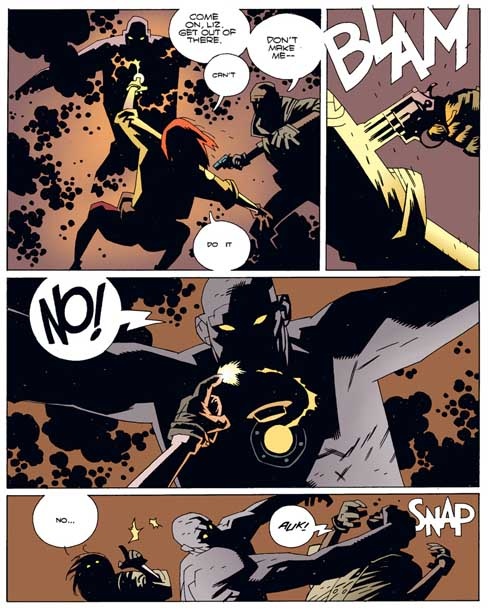

For three days he begged at the foot of the cross until at night, during an electrical storm, he was approached by a curious figure bearing a medallion that had belonged to Mischrasse. This figure was Mischrasse’s first homunculus. He had been alone all these years, but he had been busy.
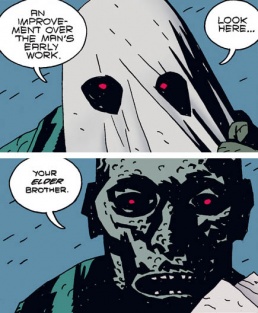
When he had learned of his brother’s resurrection, the first homunculus abandoned caution and sent his homunculus slaves raid cemeteries for raw material, taking the newest corpses. This did not go unnoticed, and the Bureau sent Hellboy and Agent Corrigan to investigate. Kate was separated from Hellboy and captured by the homunculi slaves to be used as “another onion for the soup.” This was not something the younger homunculus could allow, and he fought back against his brother in defence of Kate.
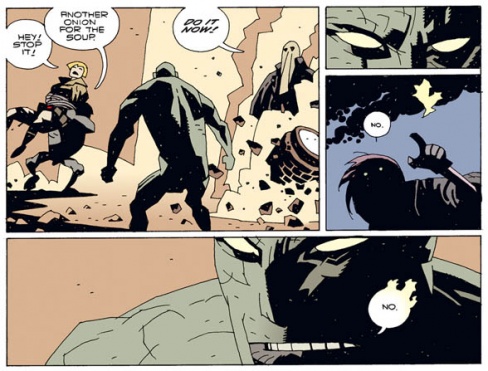
This is a major defining moment for him. This is not something drawn from Mischrasse or even Liz. He felt guilt for the way he had used Liz to gain life, and he was not going stand by and allow Kate to be used to make his brother’s colossus.
When Hellboy showed up and the inevitable fighting began, the elder homunculus entered into his new body. As the colossus, he ranted about how he was a new god and would rule humanity. Though Hellboy got in a few good hits, he was no match for the colossus, and it seemed there was no way for them to beat it. Then the younger homunculus intervened. He feigned remorse for having fought against his brother, and asked if it was too late to become a part the colossus too.
Continued below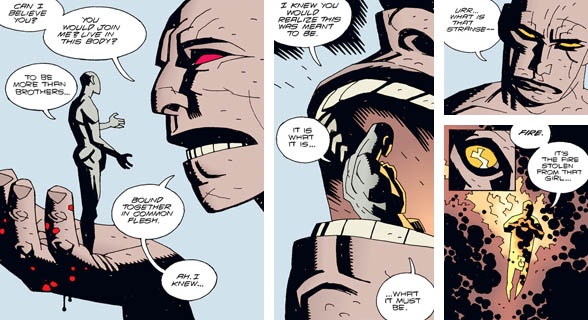
Once within the colossus’s body, the younger homunculus unleashed Liz’s power, melting his brother into a pool of molten fat. He despaired afterwards, feeling he would be forever alone after killing the only other creature like him, but Hellboy would not let him wallow in self pity. The clock was ticking. Every moment Liz was without her power, she drifted away a little more.
Hellboy fought with the homunculus, and he was harsh, but he got through him.

Afterwards, in the car on the way to the hospital, Hellboy named the homunculus Roger. This is another important moment for the character. Remember, Hellboy had no illusions about what he was asking Roger to do. Without Liz’s power Roger would be as good as dead. So what was the point of naming him? It probably would have made things easier if he hadn’t, but it the right thing to do. Roger deserved a name.

Roger was taken to the Bureau labs in Connecticut where was studied by Dr. Cobb and Dr. Roddel for several months. By November Dr. Roddel was convinced there was nothing that could be done for Roger and wanted begin dissection, despite protests by Dr. Cobb that there was still more they could try.
This exchange was witnessed by Abe Sapien who still remembered his early days the Bureau labs, and how eager Dr. Roddel had been to dissect him then. While the doctors were out for lunch, he snuck into the labs and decided to try out Dr. Cobb’s suggestion for kick-starting Roger.
And it worked.

For the next three years, Roger spent his time at the Bureau under careful observation. Roger didn’t protest his treatment. In fact, he still blamed himself for what happened to Liz Sherman and Bud Waller. He had convinced himself he was less than human. Hellboy didn’t think so though. He thought Roger was decent guy who just got off to a rough start. He talked Director Thomas Manning into letting Roger go on a simple mission, to give him the chance to become a Bureau agent. However, the mission was much more complicated than anticipated. While Hellboy was incapacitated, Roger was put in a position to act in order to save the immortal souls of innocents paying for the sins of their father. Roger did what he could to stop that, which meant killing someone. He didn’t want to, and afterwards he wasn’t even convinced it had been the right thing to do. But it had been the human thing to do.

This story, Hellboy: Being Human, has taken on a whole new aspect to it recently thanks to the flashback sequences in B.P.R.D. Hell on Earth: The Devil’s Wings, where a young Hellboy was forced to act. Not even five years old at the time, he shot a necromancer. I find it unlikely that these events echo each other so closely by coincidence. Hellboy’s influence on Roger was starting to show. Roger did exactly what Hellboy would have done in the same situation. And perhaps even Roger’s concerns about not being truly human are echoing some doubt in Hellboy too. It’s hard to tell how much of this is coming from Roger and how much is picked up through Hellboy. It’s probably a combination of the two.

I think Tom Manning was trying to do the right thing here, and if the choice had been up to him, Roger would not have been outfitted with a bomb at all. But he was stuck with that crappy job of keeping the B.P.R.D. funded by keeping twitchy bureaucrats feeling safe. If Manning had been a real jerk, he wouldn’t have put the detonator into Hellboy’s care. Still, it was a pretty crappy thing to do.
Early on in the story Roger was separated from Hellboy and met Lobster Johnson. That he was talking to a guy that was supposed to be a myth didn’t seem to cross Roger’s mind, nor the fact that if the Lobster was indeed real, he was supposed to have died sixty-two years earlier. The Lobster wanted to stop the Nazis, that’s all Roger needed to know.


Roger’s treatment in this story a big part of why Hellboy left the Bureau. Hellboy had been angry. Abe, when he heard about it, had been angry too, ready to leave the Bureau and take Roger with him. Roger though, who had more reason than any to be angry, wasn’t angry at all. Roger’s always been a very empathetic character. He could even empathise with the motives of those that feared him. His capacity for empathy is for me a key defining feature of his character, if not his most defining feature. I don’t believe it’s something he picked up from anyone else. This comes from Roger. It’s why he never hated his creator. It’s why he understood Liz. It’s why killing wasn’t easy for him.
In B.P.R.D.: Hollow Earth Liz’s life force was taken by a race of subterranean monsters. Abe, Roger, and the newly recruited Johann Kraus, took it upon themselves to get her back. Here Roger and Johann discover an interesting use for their abilities too. Johann can give the dead temporary forms with his ectoplasm, and Roger can take that ectoplasm into himself and read the nature and mind of that spirit. It’s surprising how quickly Roger started mimicking Johann after they first met. He even started speaking German. I believe this was due in large part to Roger taking Johann’s ectoplasm inside his own body when questioning the dead, and it forged a bond between them very early.
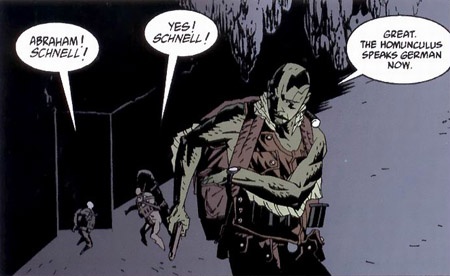
I should point out, taking the spirit of the subterranean creature into him wasn’t something Roger wanted to do, but he did it regardless, willingly to do whatever it took to save Liz. He didn’t need to be talked into it. There was no hesitation at all. When they venture into the bowels of the Earth to find her, Roger was the one that carried her body. And when they did find her, Roger again put himself in danger, using himself as a temporary vessel to guide her spirit back to her body, while simultaneously carrying a huge amount of energy that could have incinerated him at any moment. His dedication to her is beautiful.
Continued below
And it’s kind of sad because back at the Bureau there were human agents that treated him like a thing, not a person, and went out of their way to remind him how he had practically killed Liz, throwing his his most shameful moment in his face. In B.P.R.D.: Night Train Liz confessed that what had happened at Czege Castle was as much her fault as his though. When she had found Roger in Mischrasse’s hidden laboratory, she had sensed something. She hadn’t been sure what it was exactly, but she’d known it was an escape from her power. Roger didn’t just sap her power from her, she released it inside of him. Even as she had been dying, she had wanted that too. She had had enough. When Roger gave back power, it had been the beginning of her making peace with it.
In B.P.R.D.: The Soul of Venice, Roger helped free the spirit of the goddess of the canals, Cloacina. It was a relatively small story, but Cloacina had quite an impact on Roger, and he developed a fascination with her. In later stories he was shown reading books about her, and in his room there are drawings of her on his walls.

Roger also had a magpie-like tendency to collect things that caught his eye. This too doesn’t seem to be a learned trait, but rather something that’s uniquely him, and somewhat childlike. This childlike aspect of the character is something else that seems to be a core part of his personality.
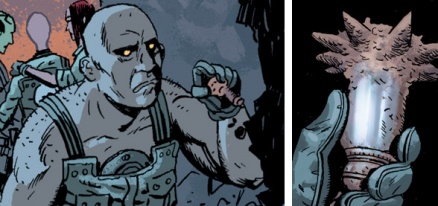
Roger had curious dreams around this time. He dreamt he was a child playing with a ball and was struck by lightning. I’ve wondered if this dream was perhaps a memory. After all, Roger’s brother had made a giant homunculus following the writings of Mischrasse, and he had used corpses to do it. I wonder if perhaps part of the raw material that had been used to make Roger had been a small child that had died after he was hit by lightning while playing with a ball. It’s possible, although there’s nothing really substantial to back up this theory.
In 2004, while investigating a rogue fungus discovered in the ruins of Cavendish Hall,2 Roger and company discovered frog monsters, similar to the ones he had previously encountered while fighting the Conqueror Worm in Hunte Castle. He and the others travelled to Crab Point, Michigan to get to the bottom of the matter, where he encountered a young girl. She soon turned into a frog monster, but Roger’s concern for the child made him hesitate to strike back.

The frog monster wrapped a chain around his neck and hung him. Fortunately, he was dead only temporarily, and a good jolt brought him back.
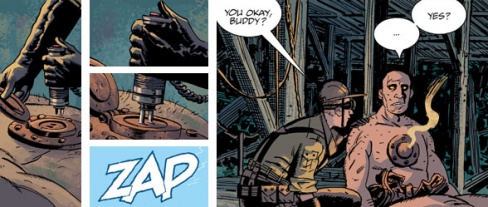
With a plague of frog monsters to deal with, the Bureau became a much more militarised organisation, which led to Captain Benjamin Daimio joining the team as their new field-team commander. Daimio really shook things up for the Bureau. He even tried to get Roger to wear pants. That didn’t go so well though.
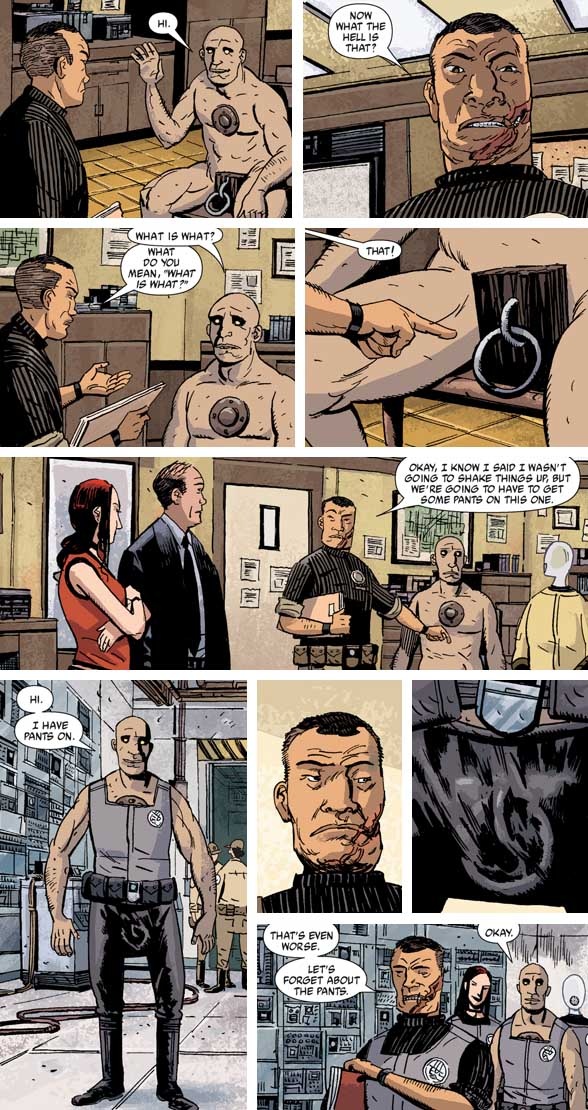
Daimio went further than just pants though. He even questioned Roger’s humanity, pointing out that his file said he was made out of horse manure and blood.3 This infuriated Liz, but surprisingly wasn’t bothered by it. He liked the Captain right away. I put this down to his empathy. Despite Daimio’s habit for rubbing the team the wrong way, Roger could tell he meant well, and he tried to smooth things over with Daimio when Liz and Johann were annoying him. Roger started working with Daimio straight away. He responded to his leadership, and in turn Daimio warmed to him rather quickly. It wasn’t long before Daimio was organising for Roger to be regularly carrying a gun.

Roger’s chapter in B.P.R.D.: War on Frogs was a unique story. Told with Roger’s internal narrative, it shone a light on just how much he had changed, delivering lines like, “You just aren’t going to let me near her, right? Or my gun… That’s why God created hand grenades.” This is not something the old Roger would have ever thought. Yet the thoughtful Roger was still there. He wondered about the humanity of the frog monsters he was fighting. He even seemed to pity them.
Three months after this, in September 2005, is when this week’s issue of Abe Sapien is set, when Roger was more distanced from his core self than he’d ever been. A big part of that story is about the conflict between who he is and who he’s trying to be, and how conscious he is of that.

March 2006. Roger was blooming as Daimio’s protégé, able to anticipate the tactics of the frog monsters and becoming quite a leader himself. And Daimio was so proud of him too. Roger had never experienced such acceptance by the regular human agents of the B.P.R.D. before. I think this love of his new-found acceptance was part of what kept him from acknowledging what was happening to him.
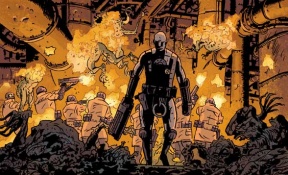
And then, out of nowhere, Roger was killed by the Black Flame.
Captain Daimio blamed himself, feeling that he had failed Roger somehow. And Abe blamed himself because ever since the Crab Point incident4 he’d avoided battle, choosing to stay at headquarters instead, when he should have been fighting by Roger’s side. But Liz took it harder than everyone. I’m going to be a little indulgent here and share her reaction to the news. These two pages break my heart every time, and this pair are my favourite pages ever drawn for the B.P.R.D. series. They are heartbreaking.

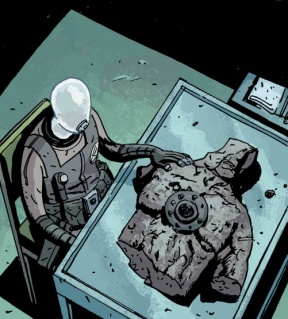
He didn’t give up hope for his friend. After all, by clinical standards Roger had never been alive. What was death for a homunculus? Not to mention his fellow B.P.R.D. agents, Liz, Daimio, Abe, and himself, had all been declared dead before and they were all still alive. Kate Corrigan made an attempt to recover the only known book that could contain the information required to regrow homunculus tissue, a copy of The Secret Flame, but it went horribly wrong, and the book was lost.
And so Johann spoke to the spirit of Roger and said his final farewell.
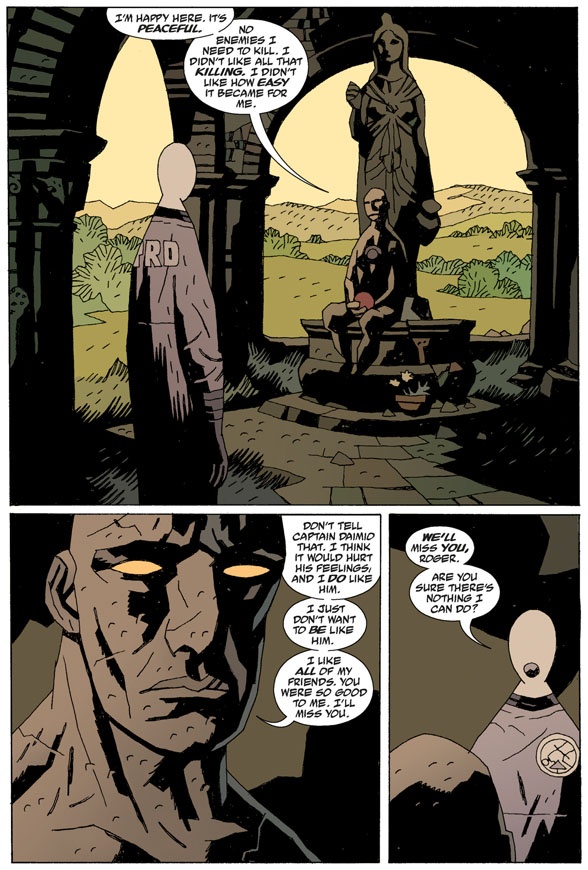
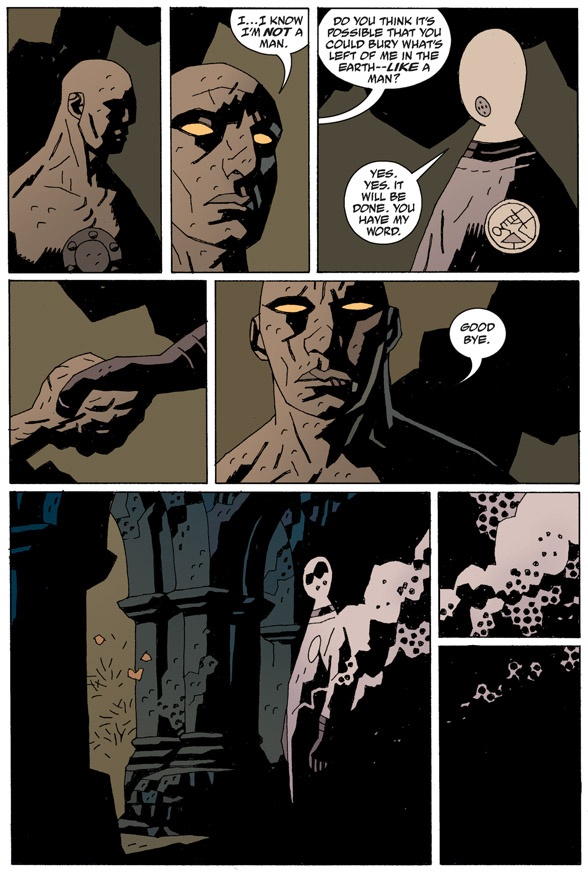
Roger’s death is one the most powerful moments in the entire Mignolaverse. In fact, it’s one that really defines it. Roger is a fan favourite character, and he died with us wanting more, yet he has stayed dead. That’s the thing about the Mignolaverse, things break and they don’t get fixed. Roger’s death is the ultimate example of that. I for one hope that he never comes back. As much as I love him, I’d like him to stay in his garden, sitting beneath a statue of Cloacina with a ball in his hands. There’s something beautiful about the simplicity of his peaceful resting place, and I don’t want that taken away.
Continued belowBut that doesn’t mean we won’t see him any more. There’s always flashbacks. In 2008 we saw Roger in B.P.R.D.: War on Frogs #1, in 2011 he showed up in Hellboy: Being Human, and tomorrow he shows up in Abe Sapien #15: Lost Lives. So don’t miss it. It seems Roger issues only come along every three years. It is a rare treat.
Thanks to Shantel LaRocque for her help on this one. And now, footnotes..
1The Verger of Saint Peter’s Church: Otherwise known as the Vampire of Prague. He was a gambler that had the misfortune to live in the city during the time of the plague. A madman and a fool, when he could find no living men to play against him, he struck up a game with the dead, and for that he was cursed to living death, cursed to haunt the streets of Prague until the end of time. (see Hellboy: The Vampire of Prague)
2The Cavendish Hall incident: May 11, 1994. Hellboy, Liz, and Abe Sapien stopped the made monk, Rasputin, from freeing the Ogdru Jahad, and destroyed Sadu-Hem. The Bureau has done follow-up investigations every six months ever since. (see Hellboy: Seed of Destruction)
3Homunculi, are incubated in manure, not made of manure. They are created using herbs, blood, and other human fluids. Captain Daimio didn’t quite get his facts right.
4The Crab Point incident: July, 2004. Sadu-Hem transformed the entire population of Crab Point into frog monsters like those seen at the Cavendish Hall incident. Agent Abraham Sapien was stabbed to death, and while dead had a vision of his own past, his life as a man called Langdon Everett Caul, and witnessed his transformation into his amphibious form. Abe was later revived and went on a sabbatical from field work.







